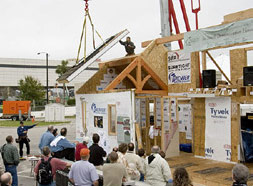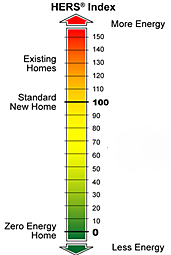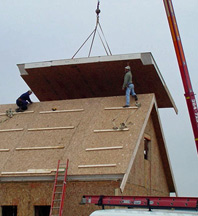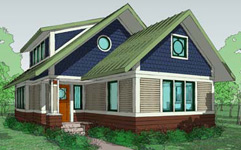By Michael Morley
 |
|
|
I met Sarah about 15 years ago, when our books, both published by The Taunton Press, came out at the same time. This was the beginning of the Not So Big phenomenon. Some years later, in 2005, Sarah designed an off-site Not So Big Showhouse for the International Builders Show in Orlando that demonstrated the principles and details of her approach. In addition, for the same show, she designed a partial demonstration house to illustrate how Structural Insulated Panels (SIPs) are used to create a highly energy efficient building envelope (SIPs were used as the structural system for Sarah's off-site showhouse, as well as for many of her previous house designs). I was asked to build this "So Small SIPS Demonstration House" in the parking lot of the Builders' Show. It featured an open front, with an 85' tall crane to install some roof panels and to attract the attendees. We put up bleachers and produced a series of stage shows, demonstrating how a house made with SIPs is assembled and detailed.
Over the next few years, Sarah and I received occasional requests for plans or a kit for that partial demonstration home. People seemed attracted to the character of a small but super energy efficient home. So we decided to turn it into a real house -- one that could be purchased as a SIPs kit, be finished by a conventional general contractor, and potentially qualify as a Net Zero Energy Home (ZEH). And with that, the Not So Big Bungalow was born!
What is a Zero Energy Home?
Simply put, a Zero Energy Home (ZEH) is a home that produces as much energy as it consumes. Some of the benefits of the ZEH approach are zero energy bills, low carbon emissions, increased home value, and improved health and comfort, not to mention easing the burden on an increasingly overloaded planet.
Building a ZEH requires an integrated design approach, of which there are three main components. First we take into account the architecture, site, orientation, and shell materials (including foundation, walls, roof, and windows and doors). The second part is to carefully select HVAC (heating, ventilation, and air-conditioning) equipment, appliances, lighting, and other energy-consuming items inside the building. The third part of this integrated design approach is to determine how to produce the alternative energy needed to balance the design loads of the home. To help with this complex task, we use an energy modeling software called REM/Design, produced by the Architectural Energy Corporation. The software is able to show the changes made during the design phase in dollar amounts, which allows the modeler and the homeowners to see real world results attained by the changes they make to the building model. So for each version of the Not So Big Bungalow that is built, we will be able to make climate specific adjustments and show the short and long term economic effects of these decisions.
The Home Energy Rating System
 The data from the modeling software is presented as a scale developed by the Department of Energy, known as the Home Energy Rating System (HERS). In this scale, 100 is the score for a reference home built to current energy codes, while a 130 score would be typical for a resale home, and a 0 score is a ZEH that has net zero energy consumption. For comparison, an Energy Star Home has to reach a score of at least 85, and in basic form (i.e. with no contribution from alternative energy strategies) the Not So Big Bungalow comes in with a HERS rating of 49.
The data from the modeling software is presented as a scale developed by the Department of Energy, known as the Home Energy Rating System (HERS). In this scale, 100 is the score for a reference home built to current energy codes, while a 130 score would be typical for a resale home, and a 0 score is a ZEH that has net zero energy consumption. For comparison, an Energy Star Home has to reach a score of at least 85, and in basic form (i.e. with no contribution from alternative energy strategies) the Not So Big Bungalow comes in with a HERS rating of 49.
Getting to ZERO
Once the total loads for the home (the maximum amount of energy the system is designed to consume) are established, then a strategy for producing energy from renewable sources to meet these loads can be developed. The energy modeling software also allows the input of different renewable energy sources and takes these into account in its economic modeling. Solar photovoltaic (PV) panels and wind power are the two most common sources for this alternative energy contribution. When the projected amount of energy generated from these sources is equal to the loads of the house, we have a ZEH.
The costs for installing the alternative energy systems and hardware can be substantial. For various reasons, homeowners may want to postpone the installation of the alternative energy production equipment. If, during initial construction, the piping and wiring for the equipment is installed and all that remains is to purchase and install the equipment, the home is said to be Net Zero Energy Ready.
The Key to Zero Energy in the
Not So Big Bungalow
 |
| Building a house with SIPs (this one is not the NSB Bungalow) |
One of the key elements of the Not So Big Bungalow design is the use of Structural Insulated Panels (SIPs) for the foundation, walls and roof of the building. SIPs have a very high insulation value, and when installed properly, provide lower air infiltration rates than any mainstream building system. It is the tightness of these homes that results in very low energy consumption, which then presents the opportunity for controlled ventilation and a very high indoor air quality (IAQ). At the core of all these decisions is a desire to provide a safe, healthy and extremely quiet environment for the occupants.
There are also economic reasons to consider a zero energy home. Many buyers today are specifically looking for homes that are very tight and well insulated, resulting in low energy bills. These features positively affect the value of the home. A home that consumes zero energy now will also consume zero energy in the future, when energy costs will inevitably be higher. The energy modeling results can accurately show the real costs of owning a zero energy home both now and in the future, based on projected energy costs. Mortgage lenders understand that operating costs are part of the equation for consumers' monthly payments, and they take this into account when calculating mortgage applications. For these reasons, Zero Energy Homes often have higher market value compared to conventional stick frame built houses.
Sarah and I have worked to create a kit of parts to assemble the building envelope for a unique, energy efficient, and truly Not So Big home. We have taken a modern home design and added a complete kit of pre-fabricated parts for the thermal/structural shell of the building, and then provided engineering, a HERS rating, and the ability to make this a Zero Energy Home, if the owners desire. For a long time home builder like myself, it doesn't get any more fun than this.
The Not So Big Bungalow
Building Envelope Kit
 The Not So Big Bungalow Building Envelope Kit contains all the components to construct the thermal/structural shell of this home, except for doors and windows. (For a complete list of materials click the link below.) The benefits of this approach to the construction process are significant. Primarily, much of the up-front work that a builder typically does before a house can be built is already taken care of with this kit. The building shell is completed in just a few days, which keeps the interior protected from the elements and thus dry and weather-tight throughout the building process. The air and moisture details included in the kit give the house outstanding durability with low to zero operating costs and very low maintenance costs -- a value that's truly enormous. The Not So Big Bungalow is a model for the way that both Sarah and I believe the houses of the future should be built, with high quality materials and techniques that minimize long term operating costs.
The Not So Big Bungalow Building Envelope Kit contains all the components to construct the thermal/structural shell of this home, except for doors and windows. (For a complete list of materials click the link below.) The benefits of this approach to the construction process are significant. Primarily, much of the up-front work that a builder typically does before a house can be built is already taken care of with this kit. The building shell is completed in just a few days, which keeps the interior protected from the elements and thus dry and weather-tight throughout the building process. The air and moisture details included in the kit give the house outstanding durability with low to zero operating costs and very low maintenance costs -- a value that's truly enormous. The Not So Big Bungalow is a model for the way that both Sarah and I believe the houses of the future should be built, with high quality materials and techniques that minimize long term operating costs.
For more information or to purchase the Not So Big Bungalow building envelope kit, click here.
 Michael Morley has been a professional builder for over 30 years. A SIP Master Builder and a certified SIP installer through the SIP School network, he has been building with SIPs since 1994. Michael is the author of Building with Structural Insulated Panels, published by Taunton Press. He is a principal of SIPsmart Building Systems, Inc., a design/build company focused on SIP system design and delivery. SIPsmart has available SIP kits for their Modern home designs as well the ARCX geodesic design variations. Michael uses his experience as a HERS energy rater to provide energy consulting services to clients and SIP training for installation crews. Visit SIPsmart at www.sipsmart.com.
Michael Morley has been a professional builder for over 30 years. A SIP Master Builder and a certified SIP installer through the SIP School network, he has been building with SIPs since 1994. Michael is the author of Building with Structural Insulated Panels, published by Taunton Press. He is a principal of SIPsmart Building Systems, Inc., a design/build company focused on SIP system design and delivery. SIPsmart has available SIP kits for their Modern home designs as well the ARCX geodesic design variations. Michael uses his experience as a HERS energy rater to provide energy consulting services to clients and SIP training for installation crews. Visit SIPsmart at www.sipsmart.com.